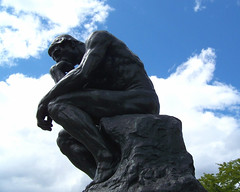 I've stated before that the Open Yale Game Theory course is a must watch for anyone interested in thinking more strategically about their work, more specifically I think it can help people working in change management or otherwise trying to incite people to action.
I've stated before that the Open Yale Game Theory course is a must watch for anyone interested in thinking more strategically about their work, more specifically I think it can help people working in change management or otherwise trying to incite people to action.Key Concepts: backwards induction, best response and Nash equilibrium
One of the rules of game theory is to put yourself in the other player's shoes. The reasoning that informs the rule is simple: you need to understand how players will react to each others strategies as they interact with one another. Once you understand how each of the other players react you can reason backwards from the end of the game to determine the best course of action moving forward, this process is called backwards induction.
Another important rule in game theory is that players will always play a best response to other players. In other words, players don't generally select sub-optimal strategies on purpose. When every player plays their best response the game has achieved a Nash equilibrium. Colloquially referred to as the point of no regrets, the Nash equilibrium is the point at which every player has done the best they can given the actions of all the players.
The link to inciting action
We could think of the status quo as the current Nash equilibrium, no one seems to have a strong incentive to deviate given the responses of everyone else. Change management then is akin to setting a new Nash equilibrium. Given what I know about game theory, I think it provides a unique insight on how exactly to achieve this:
The link to inciting action
We could think of the status quo as the current Nash equilibrium, no one seems to have a strong incentive to deviate given the responses of everyone else. Change management then is akin to setting a new Nash equilibrium. Given what I know about game theory, I think it provides a unique insight on how exactly to achieve this:
- determine the desired outcome
- put yourself in that person's shoes
- use backwards induction
- determine what would incent others to move towards the desired outcome
- amend your own behavior in order to realign the responses of others
The lesson, I think is simple. If you want to incite others to change, you yourself will have to be willing to change, perhaps this is what Gandhi meant when he said, "be the change you want to see in this world".
[image credit: Maia C]






No comments:
Post a Comment